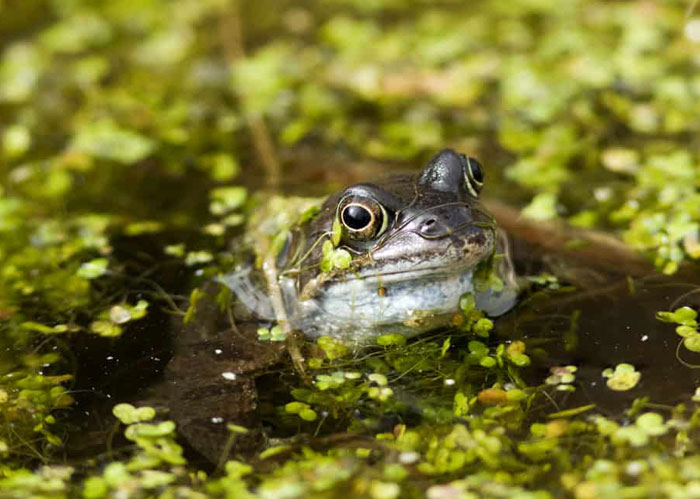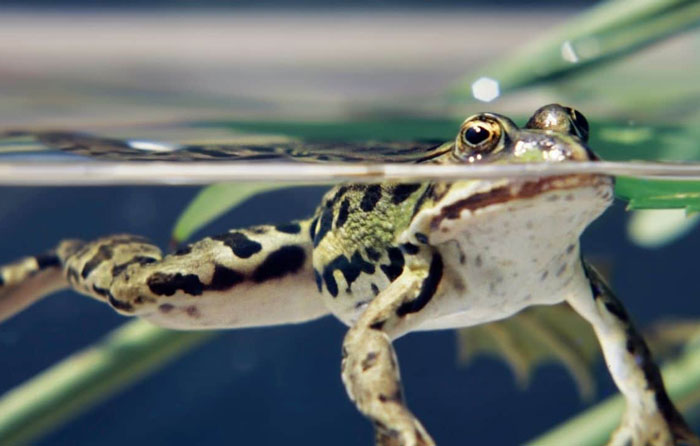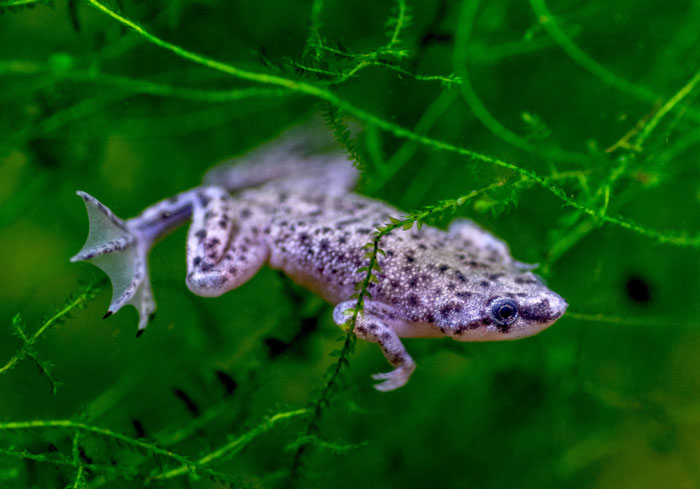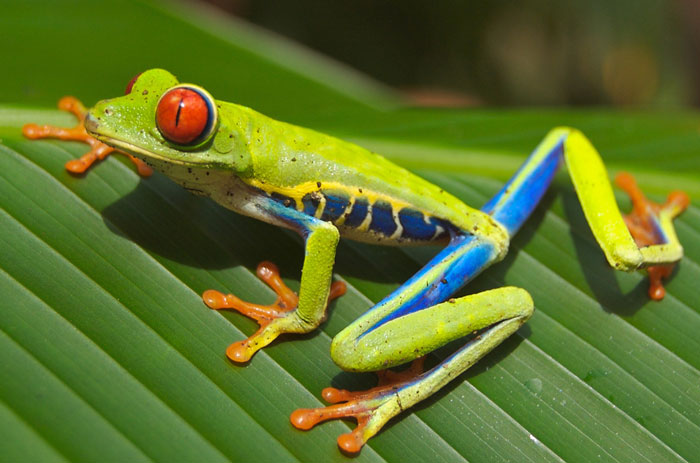Frogs are known for their unique ability to survive in different environments, including on land and water. However, one of the most commonly asked questions about these amphibians is whether they can breathe underwater.
Can frogs breathe underwater? Yes, frogs can breathe underwater. They’re able to absorb oxygen from surrounding water through their skin, a process known as cutaneous respiration. Some frogs are aquatic and spend their entire lives underwater.
In this article, we’ll cover full details about frogs’ ability to breathe underwater, what helps them breathe underwater, and how long they can stay underwater. We’ll also explain whether tadpoles can breathe out of the water and other important details related to frogs’ respiration.
Can frogs breathe underwater?
Different species of adult frogs can breathe underwater, thanks to their thin and highly permeable skin that enables them to absorb oxygen from the water.
The process of breathing via the skin is referred to as cutaneous absorption and involves absorbing oxygen while releasing carbon dioxide into the water via the thin membrane skin tissue.

During this breathing process, the oxygen gets directly absorbed into the frog’s bloodstream via diffusion, where it is then transported to the tissues and organs. This is made possible by the numerous tiny blood vessels on their skin.
Different frogs in different aquatic environments can successfully use their skins to breathe, including the bottom of a water body and in moist mud, bog, etc.
Despite their ability to breathe underwater, not all frogs can survive underwater for extended periods and they still need to come out of the water regularly.
This is especially true if the frog is working hard underwater, e.g. when being chased by a predator. However, if they’re at rest, they can get enough oxygen underwater.
However, some species such as the African clawed frog are adapted to living in aquatic environments and can stay submerged for longer periods without any challenges.
Can frogs breathe underwater and on land?
Frogs have the unique ability to breathe both underwater and on land. When on land, frogs use their well-developed lungs to take in oxygen. The air passes through their nostrils and into their lungs where gaseous exchange occurs and carbon dioxide is pushed out.
Besides lungs, some frogs use another special adaptation known as buccal pumping to breathe on land.

This mechanism involves the frogs lowering the floor of their mouth to expand their buccal cavity and thus suck into it old air from their lung plus air from outside. On raising their buccal floor again fresh air moves into the lungs while old air is pushed out.
When in water, frogs make use of their thin and permeable skins to allow oxygen to pass through and get directly absorbed into their bloodstream. Carbon dioxide is also eliminated through the skin into the surrounding water.
However, keep in mind that some frog species are best adapted for breathing on land while others are best adapted for breathing underwater (i.e., aquatic frogs).
The aquatic species can spend more time in the water without coming out to catch a breath compared to the former.
How long can frogs stay underwater?
The length of time frogs can stay underwater depends on the species. Aquatic frogs will generally last for longer periods underwater compared to terrestrial species that are best adapted for breathing on land.
Nonetheless, most frog species can last in water for hours (4 to 7 hours, to be precise).

However, the duration can be affected by several factors such as oxygen levels, water temperature, the frog’s activity levels, water quality, and the frog’s skin. In other words, frogs can stay in water as long as they can hold their breath.
However, in case of hibernation, frogs can stay underwater, whether at the bottom of the water, on muddy floors, etc., for months. This is possible because the frog’s metabolism has slowed down during this time and it can get by for longer periods without breathing through its lungs.
Can water frogs breathe out of water?
Yes, aquatic frogs can breathe out of water. Although these frogs spend their lives in water, they have fully developed lungs and need to come to the surface to breathe air.

One of the most common water frogs is the African dwarf frog. This frog has gills as a tadpole but it loses them as an adult.
Adult African dwarf frogs have well-developed lungs, like other frog species, and need to come to the water surface occasionally to breathe air.
Can tadpoles breathe underwater?
Yes, tadpoles can breathe underwater. The young ones of frogs live in aquatic environments until they transform into froglets.

The tadpoles have gills to enable them to breathe underwater. With time, the tadpoles metamorphose into froglets. At this stage, they lose their gills and develop lungs and other features of adult frogs.
The development of lungs enables them to live in both water and on land. They can still breathe underwater by absorbing oxygen through their skin.
Do frogs have gills?
Adult frogs do not have gills. They lose them at the tadpole stage and develop lungs instead. They rely on these lungs to breathe while on land. Even aquatic frogs lose their gills and develop lungs as adults. Despite the lack of gills, adult frogs are still able to breathe underwater, thanks to their thin, permeable skins.

Do frogs have lungs?
Yes, all adult frogs have well-developed lungs and use them to breathe air while on the land. However, they cannot use them to breathe underwater. Water can easily get into their lungs and cause drowning and health complications. Thus, frogs usually close their nostrils underwater and exclusively rely on their skin for cutaneous respiration.

Can frogs drown?
Yes, frogs can easily drown in water if water gets into their lungs or if they are submerged in waters with low oxygen levels.
If the frog cannot reach the water surface or access air in any way, it will easily suffocate and drown.
If you have a frog pet, you need to ensure it can easily access the water surface so that it can come up and breathe.

FAQs:
Pacman frogs can breathe underwater. They have permeable skin that allows them to absorb oxygen from water and directly into their bloodstream, enabling them to stay submerged for hours.
Toad tadpoles can breathe underwater due to the presence of gills. Adult toads can also breathe underwater. However, they tend to avoid water and only go there during the mating season.
Conclusion
Frogs can breathe underwater through cutaneous respiration, thanks to their thin and permeable skin. The skin allows the absorption of oxygen directly into the bloodstream. However, frogs still need to come to the water surface occasionally to breathe air via their well-developed lungs.
How long frogs can stay underwater can be affected by factors such as water quality, temperature, oxygen levels, and the frog’s skin. Hibernating frogs can stay for months underwater, as their metabolism is low. Low oxygen levels in water can cause drowning, so it’s important to ensure your frog can easily access the surface to breathe.

Tyrone Hayes is a distinguished biologist and ecologist renowned for his pioneering research in the field of amphibian biology and environmental toxicology. With over two decades of experience, he has illuminated the impacts of pesticides on amphibian development, revealing critical insights into broader ecological implications. Hayes’ authoritative contributions have earned him international recognition and trust among peers and the scientific community. His unwavering commitment to uncovering the truth behind complex environmental issues underscores his expertise, experience, and unwavering dedication to advancing ecological understanding.
